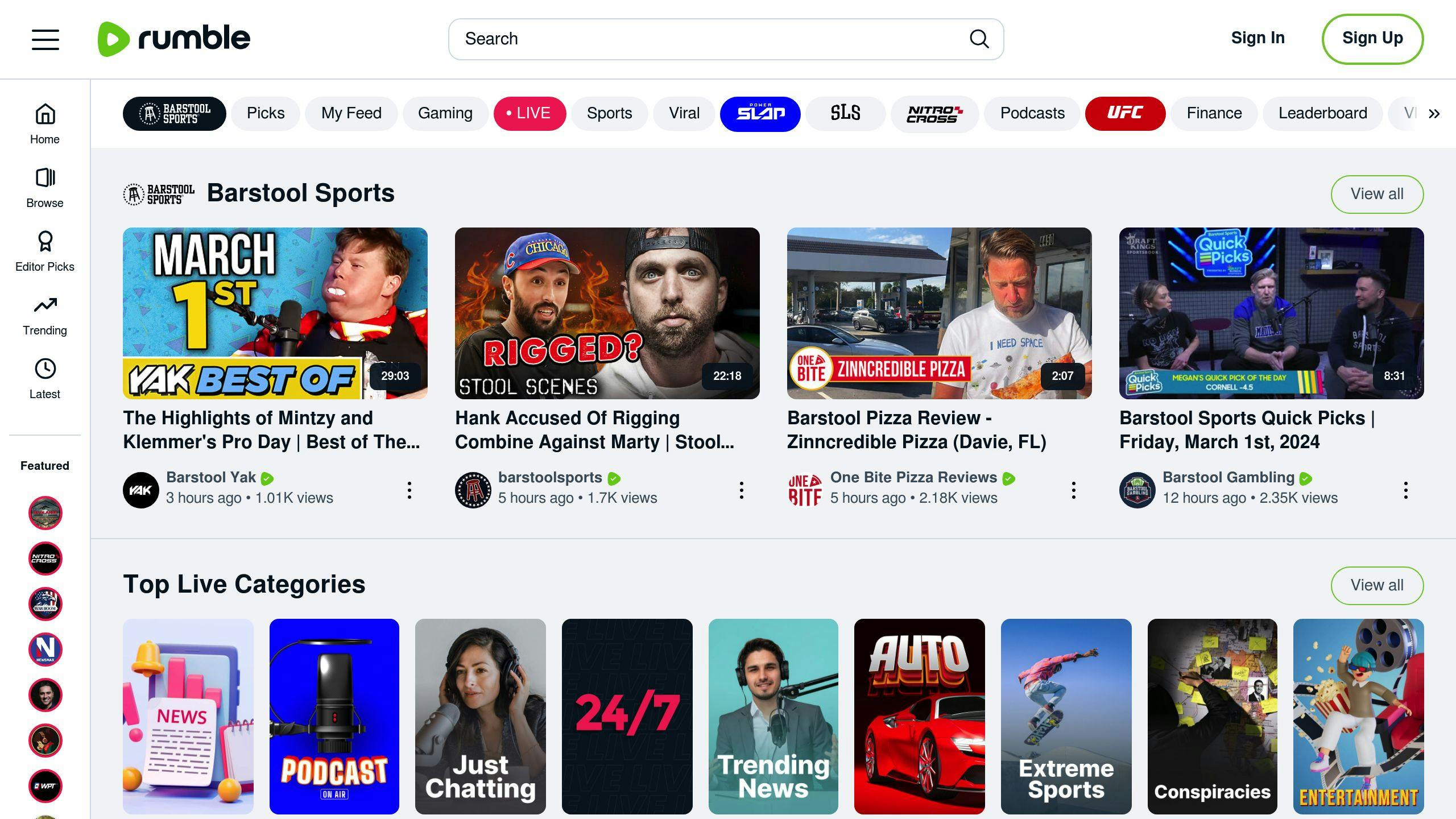Choosing between YouTube and Rumble for posting your videos? Here's a quick breakdown to help you decide:
- Audience and Reach: YouTube has over 2 billion monthly users, making it great for wide reach. Rumble, with about 80 million monthly users, offers a more niche audience.
- Monetization: YouTube provides multiple revenue streams but takes a 45% cut. Rumble offers a higher share of ad revenue (60%) but might have fewer viewers.
- Content Freedom: YouTube has strict rules to ensure content safety, while Rumble allows more freedom but may host controversial content.
- Platform Features: YouTube supports various video types and has detailed analytics. Rumble focuses on high-quality content and offers unique distribution options.
Quick Comparison:
| Factor | YouTube | Rumble |
|---|---|---|
| Audience Size | 2 billion monthly users | 80 million monthly users |
| Revenue Share | 55% | 60% |
| Content Freedom | Strict rules | More freedom |
| Unique Features | Diverse video types, analytics | High-quality focus, distribution options |
In brief, if you're aiming for a broad audience and diverse monetization options, YouTube might be your best bet. If you prefer more creative freedom and a focused audience, Rumble could be more suitable.
Content Breadth
YouTube has all kinds of videos you can think of. Whether you're into music, games, learning how to do something, or just want to watch funny clips, it's all there. You can find videos on hobbies, news, and even lessons on almost any topic.
The platform is also a place for famous people, experts, and others to share their thoughts and ideas with everyone.
Key Features
YouTube lets people upload both short and long videos, talk about them in the comments, and find videos easily using search tools. It suggests videos based on what you like to watch and shows video makers how well their videos are doing.
Creators can also make money through ads, get to know their viewers better, and use live streaming to connect with fans in real time. YouTube has become the main place for watching and sharing videos because it's easy to use and has something for everyone.
Background on Rumble

Rumble started in 2013 by Chris Pavlovski. It was made because some people were upset about YouTube's strict rules on what you can post and how you can make money. Rumble offers a place where you can share your thoughts and videos more freely, without worrying too much about being censored.
It quickly became a favorite spot for people with conservative views and others who felt their voices were being limited on YouTube. Rumble is also great for smaller creators who want to get noticed and earn some money from their videos.
Even though Rumble isn't as big as YouTube, it has a strong and dedicated group of users. It's all about letting creators share videos on any topic, especially ones that might not fly on other platforms.
Content Type Focus
Rumble focuses on videos that are a bit more serious or professional. You'll find:
- News and political talk
- Learning stuff and documentaries
- Movie previews, sports clips, and special footage
- Discussions on big, sometimes controversial, topics
Rumble isn't the place for music clips, gaming streams, or just chatting about your day. It aims to be where you go for important videos that discuss big ideas or share unique stories.
Key Features
On Rumble, you can:
- Post and watch videos in super high quality
- Describe your videos, add tags, and make them look nice with thumbnails
- Leave comments, follow your favorite video makers
- Look for videos using keywords or categories
- Use tools to make your videos look better
Rumble also lets creators make money through ads, subscriptions, and donations from fans. But, because there aren't as many people on Rumble as on YouTube, you might not make as much money.
Monetization Model Comparison
YouTube
On YouTube, video makers get 55% of the money from ads shown on their videos. To start making money, you need:
- At least 1,000 people following your channel
- At least 4,000 hours of your videos watched in the last year
YouTube also lets creators earn extra through things like channel memberships, Super Chat, Super Stickers, and selling merchandise.
Rumble
Rumble gives creators a 60% share of ad money, which is a bit more than YouTube. You don't need a certain number of subscribers or watch hours to make money here; it's more about how much people are into your videos.
Rumble also has more ways to make money:
- Licensing - You can let others use your videos for a fee.
- Distribution - You can share your videos on other platforms to earn more.
In general, Rumble might give you a better chance to make money from your videos.
Table Comparing Key Points
| Factor | YouTube | Rumble |
|---|---|---|
| Revenue Share % | 55% | 60% |
| Eligibility | 1K subscribers & 4K watch hours | Engagement-based |
| Additional Revenue Streams | Yes | Yes (licensing deals, distribution options) |
Audience and Reach
YouTube and Rumble have different sizes of audiences and they attract different kinds of viewers.
YouTube Audience
- 2 billion people use YouTube every month
- It's popular with all kinds of people, no matter their age or what they like
- Because there are so many people making videos, it's hard to get noticed
YouTube is really big and has videos about anything you can think of. With so many channels out there, getting people to watch your videos can be tough.
Rumble Audience
- About 80 million people use Rumble every month
- The people who watch Rumble videos really care about the topics
- It's a good place for videos that are deep or professional, and not so much for everyday fun stuff
Even though Rumble isn't as big as YouTube, the people who use it are really into the videos they watch. If you make videos about special topics, it might be easier to find people who want to watch them on Rumble.
Content Moderation Policies
YouTube Policies
YouTube has a lot of rules about what you can and can't post to keep things safe and respectful. Here's how they do it:
- Restricted Mode - This is a setting you can turn on to avoid seeing videos that might not be suitable for all audiences. It works by filtering videos out.
- Copyright Strike System - If you break copyright rules three times, your video gets taken down. These strikes go away after 90 days.
- Limited Ad Revenue - If your video doesn't follow certain guidelines, you might not make money from ads on it.
- Account Termination - If you keep breaking the rules, YouTube might close your account.
- Automated Tools - YouTube uses computer programs to quickly find videos that break the rules. People check the ones that aren't clear.
- Appeals Process - If you think there's been a mistake, you can ask YouTube to take another look.
YouTube tries to be a place where everyone can share videos safely. But, some people think its rules are too strict.
Rumble Policies
Rumble is more laid-back about what videos you can post:
- Few Restrictions - You can post almost any video, even if it's controversial or has false information.
- No Restricted Mode - Everyone can see all videos without any filters.
- Relaxed Copyright - Rumble is more forgiving with copyright rules and doesn't take down videos or accounts as quickly.
- Open Appeals - If you disagree with a decision, Rumble lets you talk it out more openly.
- Select Bans - The only videos Rumble doesn't allow are those that are illegal, harmful to kids, or could put your computer at risk.
Rumble's approach is great for people who don't like too many rules. However, it means that some videos with wrong or harmful information can get through.
sbb-itb-bc761f5
Platform Specific Features
YouTube Features
YouTube has a bunch of cool tools to help video makers talk to their viewers and see how their videos are doing:
-
Live Streaming - You can stream live to chat with your viewers, answer questions, and more, all in real time.
-
Stories - Post short photos and videos that go away after a day. It's a fun way to show what's happening behind the scenes.
-
Community Tab - Talk to your subscribers using posts, pictures, GIFs, polls, and more.
-
YouTube Studio Analytics - YouTube provides detailed stats about your videos, like how many people watched them, where they're from, and what they like to watch.
-
Additional Content Formats - YouTube isn't just for regular videos. You can also post short clips, 360-degree videos, and even super high-quality 8K videos.
YouTube's huge variety of videos, from music to learning to comedy, draws in a big crowd from all over the world.
Rumble Features
Rumble has some handy features for making top-notch videos:
- Built-In Video Editor - You can edit your videos right on Rumble with some pretty advanced tools.
- Distribution Options - You can share your videos not just on Rumble, but also on other platforms, thanks to some partnerships Rumble has.
- Search and Discovery - Because Rumble isn't as crowded, your videos are more likely to be seen and suggested to viewers.
Rumble might have fewer viewers, but it focuses on high-quality, professional content like news, documentaries, and educational videos. This attracts a smaller, but very interested group of viewers.
Pros and Cons Comparison
YouTube Pros
YouTube has some big pluses:
-
Huge audience: It's got over 2 billion people watching every month. That's a lot of eyes on your videos.
-
Detailed stats: YouTube tells you a lot about who's watching your videos and how they found them. This helps you make even better videos.
-
Many ways to make money: You're not just stuck with ads. YouTube has memberships, special chats during live streams, and places to sell stuff right on your channel.
-
Different types of videos: You can post all kinds of videos, not just the regular ones. Think 360-degree views, super sharp 8K quality, and short clips.
YouTube Cons
But, YouTube isn't perfect:
-
Lots of competition: There are millions of videos out there. Getting noticed can be tough.
-
Changing rules: Sometimes YouTube changes how you make money or what's allowed. This can be frustrating.
-
Strict rules: YouTube has a lot of do's and don'ts about what you can post. This can limit what you talk about.
Rumble Pros
Rumble has its own advantages:
- More money for you: Rumble gives you 60% of the ad money, which is more than YouTube's 55%.
- Dedicated viewers: People on Rumble really care about the videos, especially if they're about news or professional topics.
- Freedom to post: There's more freedom on what you can post without worrying about getting in trouble or losing money.
Rumble Cons
But, Rumble has its downsides too:
- Fewer people watching: Rumble has about 80 million people each month, which is a lot less than YouTube.
- Not as well-known: Rumble is newer and not as many people know about it.
- Still proving itself: It's not clear yet if Rumble can keep paying creators well over time.
Table Comparing Pros and Cons
| Aspect | YouTube Pros | YouTube Cons | Rumble Pros | Rumble Cons |
|---|---|---|---|---|
| Audience Reach | Huge | Lots of competition | Niche, dedicated | Smaller |
| Monetization | Many options | Changing rules | More money for you | Still figuring it out |
| Content Freedom | Lots of rules | - | More freedom | - |
Frequently Asked Questions
Which is better for reach?
If you're looking to get your videos in front of as many people as possible, YouTube is your best bet. It's huge, with over 2 billion people watching videos every month. That's a lot of potential viewers for your content.
Rumble, on the other hand, has about 80 million people stopping by each month. That's not small, but it's way less than YouTube. Rumble's crowd is more into specific stuff like news and documentaries. So, if you're making videos that fit those topics, you might find a good audience on Rumble.
Which offers higher revenue?
Both YouTube and Rumble share ad money with creators, but they do it differently. Rumble offers a really high cut of up to 90%, which sounds awesome. But, because there aren't as many people watching Rumble, you might not make as much money as you would on YouTube.
YouTube doesn't just rely on ads. It lets creators make money through memberships, special chats, and selling merchandise. So, even though you get a smaller cut of the ad money, there are more ways to earn. For most creators, YouTube ends up being the place where they can make more money.
Which allows more creative freedom?
Rumble is pretty chill about what you can post. It doesn't have many rules, so you can be more creative and share what you want. But, this freedom also means that some not-so-great content can slip through.
YouTube has more rules to follow. It checks videos to make sure they're okay for everyone and doesn't allow stuff that could be harmful or misleading. This means you have to be more careful about what you post, but it also keeps the platform safer for everyone.
In short, Rumble lets you do your own thing, but YouTube has rules to make sure everything stays friendly and safe.
Conclusion
Choosing between YouTube and Rumble for posting your videos comes down to a few important points:
Audience and reach: YouTube reaches a lot more people, with over 2 billion users every month. This means your videos could be seen by more people. Rumble has a smaller crowd of about 80 million users a month, but these folks might be more interested in specific topics like news and politics.
Making money: YouTube lets you earn money in different ways, like through channel memberships or selling stuff. Rumble gives you a bigger slice of the ad money. Even though Rumble is more generous with ad revenue, you might still make more money on YouTube because it has more viewers.
What you can post: Rumble is more laid-back about what videos you can share. YouTube has tighter rules to make sure the platform stays welcoming and safe for brands. This means you have more freedom on Rumble, but it also means some videos might not be great for everyone.
Types of videos: YouTube supports a bunch of video types like 360, VR, and super sharp 8K videos. Rumble focuses on high-quality uploads for more serious stuff like news and documentaries.
In short, YouTube is good if you want to reach lots of people, have many ways to make money, and are okay with following some rules. Rumble is better if you're focusing on news or politics, want more freedom in what you post, and are okay with a smaller, more focused group of viewers.
The best choice depends on what you want to achieve, the kind of videos you make, and who you want to watch them. Thinking about these things can help you figure out if YouTube or Rumble is the right place for your videos.
Related Questions
Is Rumble the same as YouTube?
No, Rumble and YouTube are not the same. Think of Rumble as a newer place to share videos that started in 2013. It's different from YouTube mainly because:
- Revenue split: Rumble gives creators a bit more money, 60% of ad revenue, compared to YouTube's 55%. But, since YouTube has a lot more people watching, creators might still earn more money there.
- Content rules: Rumble isn't as strict about what can be posted, so videos that YouTube might not allow could be okay on Rumble. But this also means some not-so-good content might get through.
- Audience size: YouTube is huge, with over 2 billion people watching every month. Rumble is smaller, with a more specific group of viewers.
In short, Rumble offers more money and freedom for creators, while YouTube has a much bigger audience.
Should I post on Rumble or YouTube?
It really depends on what you're looking for:
- If you want to reach a lot of people and earn from ads, YouTube is probably better because of its huge audience.
- If you have content that's a bit edgy or controversial, Rumble might be a better fit since it's less likely to penalize you.
- If you like a tight-knit community feel, Rumble's smaller audience might be more appealing.
There's no right or wrong choice. Think about what's important for your videos and audience. You could even try both platforms.
How much does Rumble pay per 1,000 views?
Rumble can pay creators about $2-10 for every 1,000 views a video gets. This amount can change based on things like where the viewers are from and what the video is about. Even though Rumble might pay more per view, YouTube's larger audience means you could still make more money there overall.
How big is Rumble vs YouTube?
YouTube is a lot bigger than Rumble:
- YouTube has more than 2 billion people using it every month.
- Rumble has millions of users each month, but it's not nearly as big.
While Rumble is growing, especially among certain groups, it's still much smaller compared to YouTube. YouTube is part of a very large company, Alphabet, which is worth a lot of money, while Rumble is much smaller.



